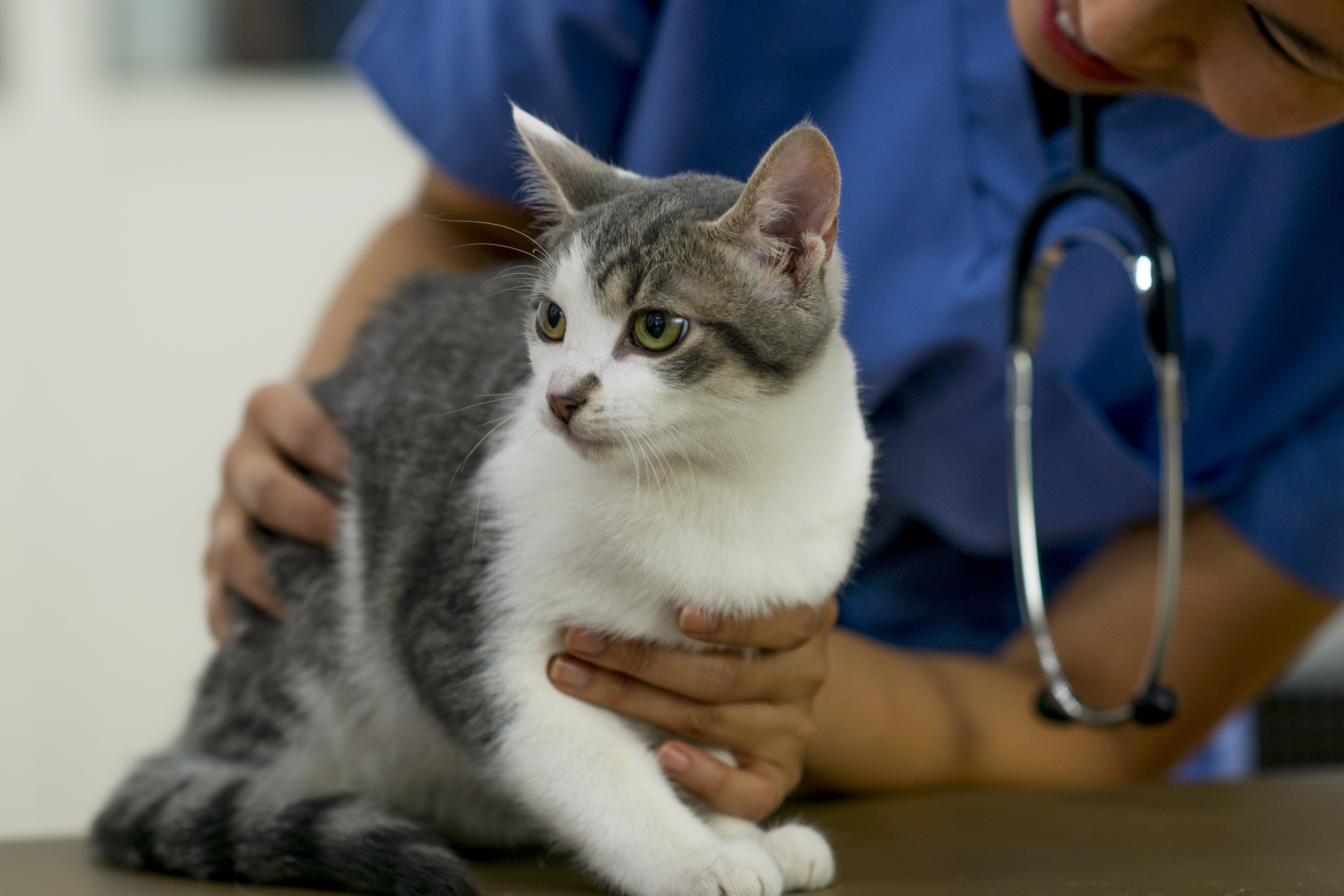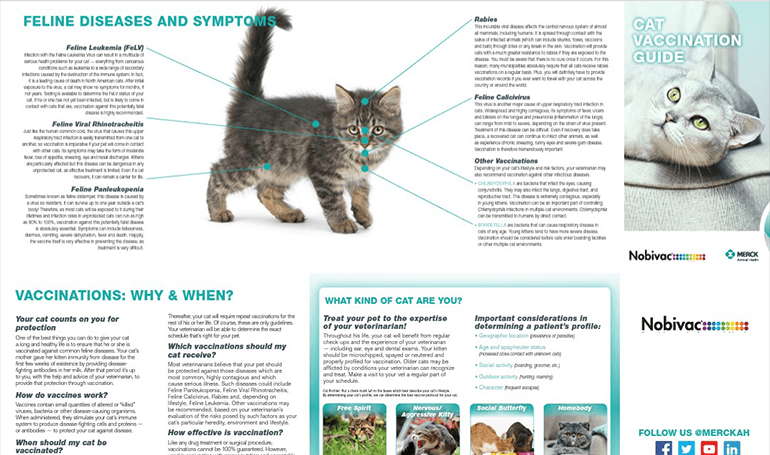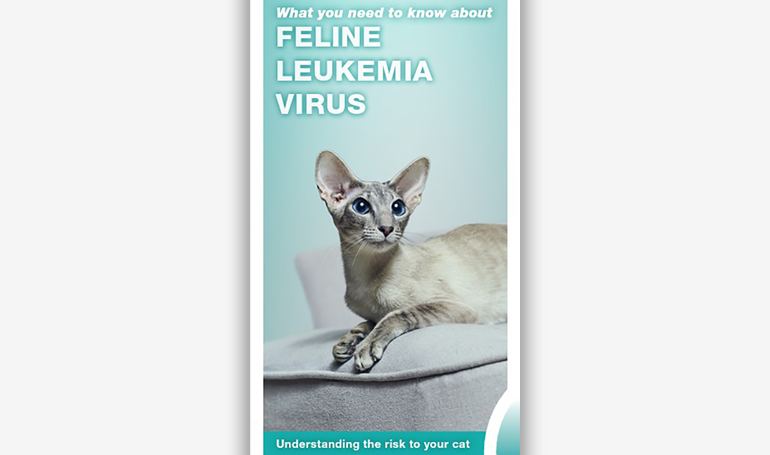

Feline Leukemia
Despite the widespread use of vaccines, feline leukemia virus (FeLV) remains one of the most important causes of morbidity and mortality in cats.
Overview | Transmission | Signs | Risk Factors | Outcomes | Spreading | Diagnosis | Vaccines | Resources
Disease Overview
Feline leukemia virus (FeLV) is a retrovirus that replicates within many tissues, including bone marrow, salivary glands, and respiratory epithelium.6,7
FeLV is a retrovirus in the family Oncovirinae. There are 4 FeLV subgroups of clinical importance. FeLV-A, the original, archetypical form of the virus, is efficiently transmitted among cats. Within the infected cat, in addition to the original FeLV-A mutated forms, FeLV-B, FeLV-C, or FeLV-T exist. FeLV-B increases the frequency of neoplastic diseases, FeLV-C is strongly associated with the development of erythroid hypoplasia and consequent severe anemia, and FeLV-T has the propensity to infect and destroy T lymphocytes, leading to lymphoid depletion and immunodeficiency.
FELINE LEUKEMIA FAST FACTS
- Feline Leukemia causes a variety of malignancies; persistent infection can cause severe immunosuppression and profound anemia.
- The virus is present worldwide and infects domestic cats and a few other Felidae.
TRANSMISSION
- FeLV in saliva, nasal secretions, urine, feces, and blood is transmitted to healthy cats during intimate contact with infected cats.
- Kittens can acquire the virus from infected mothers while still in the womb or through nursing.
- Social behavior such as mutual grooming and sharing food or water dishes, or litter trays is the most common means of transmission.6
- Bite wounds from infected cats are an efficient mode of transmission but occur infrequently in indoor cats.
CLINICAL SIGNS
- Fever
- Loss of appetite
- Weight loss
- Diarrhea
- Swollen lymph nodes
- Pale or inflamed gums
- Clinical signs can be variable due to immunosuppression
CATS AT RISK
- Boards often or comes from a shelter environment
- Lives in a multiple cat household
- Is a rescue cat or from a feral cat population
- Kittens are at higher risk of infection than adult cats7
- Sharing food and water bowls, and common litter areas7
- Outdoor cats are at higher risk
MORBIDITY THREATS
FeLV-related disorders include immunosuppression, neoplasia, anemia, immune-mediated diseases, reproductive problems, and enteritis. Reproductive problems are common.
The immunosuppression caused by FeLV results in an increased susceptibility to bacterial, fungal, protozoal and other viral infections.Virus may persist as a latent infection sequestered in the bone marrow. Persistently viremic cats develop fatal diseases after a variable time period.
Lymphoid or myeloid tumors develop in up to 30% of cats persistently infected with FeLV.
FeLV occasionally causes a neuropathy leading to anisocoria, urinary incontinence, or hindlimb paralysis.
SPREADING DISEASE
The incidence of FeLV infection is directly related to the population density of cats.
The virus first replicates in oropharyngeal lymphoid tissue. From there, it is carried to the spleen, lymph nodes, epithelial cells of the intestine and bladder, salivary glands, and bone marrow.
It then appears in secretions and excretions of these tissues and in leukocytes and platelets.
Occasionally, infected queens give birth to live, viremic kittens. Latently infected (ie, nonviremic) queens may pass virus on to their kittens in milk.
In ~70% of adult cats, viremia lasts only 1–16 weeks. A few cats continue to shed virus in secretions for several weeks to months after they cease to be viremic.
DIAGNOSIS
Two types of tests are readily available for clinical use. The immunofluorescence assay (IFA) tests for the presence of FeLV structural antigens (eg, p27 or other core antigens) in the cytoplasm of cells suspected to be FeLV-infected.
Diagnosis of FeLV-induced neoplasia is similar to that of other tumors. Cytologic examination of fine-needle aspirates of masses, lymph nodes, body cavity fluids (eg, pleural effusion), and affected organs may reveal malignant lymphocytes.
Bone marrow examination may reveal leukemic involvement, even when the peripheral blood appears normal. Biopsy and histopathologic examination of abnormal tissues is often necessary for diagnostic confirmation.
Merck Animal Health Vaccines

NOBIVAC® FELINE 1-HCP+FeLV
A quality 1-year core vaccine that protects cats against 3 viral infections-calicivirus, herpesvirus, and panleukopenia.
ALSO AVAILABLE
Professional Resources and Educational Materials
Keep your clinic and staff informed and aware of diseases and outbreaks.

Feline Vaccination Guide
Brochure
A guide to help your pet parents understand common feline diseases and the importance of customizing vaccination for their pet’s unique lifestyle.

Feline Leukemia Virus
Brochure
Educate your clients about FeLV with this easy to share brochure.
No items to show.

